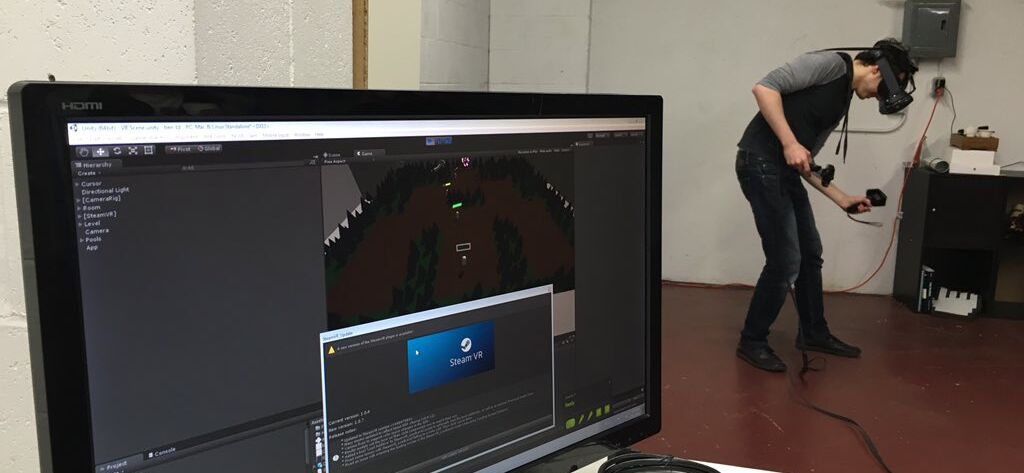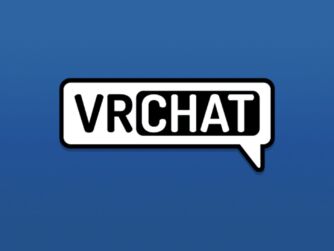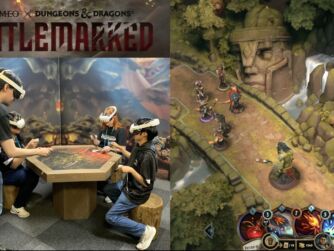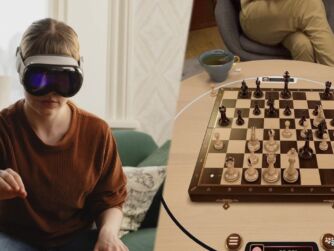 Kayla Kinnunen is a game director at Roadhouse Interactive, which is an independent game development studio based out of Vancouver, BC. She talks about her process of evangelizing VR at her studio and slowly ramping up a VR team. She made a goal to put every one of Roadhouse’s 150 employees through a Vive demo loop, and she talks about what discovered in doing this as process well as how a indie game studio is thinking about VR.
Kayla Kinnunen is a game director at Roadhouse Interactive, which is an independent game development studio based out of Vancouver, BC. She talks about her process of evangelizing VR at her studio and slowly ramping up a VR team. She made a goal to put every one of Roadhouse’s 150 employees through a Vive demo loop, and she talks about what discovered in doing this as process well as how a indie game studio is thinking about VR.
LISTEN TO THE VOICES OF VR PODCAST
Seeing the Valve demo room at the Steam Dev Days gathering in early 2014 convinced Kayla Kinnunen that VR has a transformational potential, and now nearly two years later we’re approaching the consumer launch of the first VR HMDs. There’s still a lot of risk to dive all into to VR game development, and so Kayla talks about her process over the past couple of years to do some internal evangelizing of VR.
She decided that the best way to establish a baseline of conversation about VR was to first give all 150 employees of Roadhouse Interactive a wide range of Vive demos over the course of about 30 minutes. She wanted to build a consensus around what VR is, what works in VR, as well as what doesn’t work.
She slowly tweaked a demo loop that has a logical progression of showing specific mechanics. She starts with the constraint-free 3D graffiti painting application of Tiltbrush before putting on headsets so that people could get used to what it feels like to have frictionless creation within VR. She then puts on headphones and puts them through the TheBlu: The Encounter in order to demonstrate what a linear storytelling cinematic VR experience looks like. Then she shows Valve’s Apature Robot Repair for what high-fidelity animation can do, but with limited interactivity. She shows Job Simulator for a highly interactive experience, and then finally ends with Fantastic Contraption for a full-on, world-building experience.
After going through demos, she’s been seeing a lot of excitement as well as lot of ideas being brainstormed. She created a Unity test project that developers can download and start to experiment with VR on their own time. She’s been slowly recruiting internal developers in order to do rapid prototypes in order to quickly interate and continue to experiment with what types of game mechanics seem to work really well.
Kayla reflects a lot of the sentiment at the VRX conference in that 2016 will likely be a year where VR will continue to have a lot of experiments and early explorations as the install base starts to be established within the consumer VR market. It’s obviously too risky of a move to completely shift over all of their development resources, and will instead slowly build out some experiences over the next year.
She’s really excited about how VR can be used as a positive force in the world, and how it could amplify our humanity. She expects that social multiplayer games will help us feel a connection to other people, and that VR can appeal to a broader range of people beyond just gamers because the interface is a lot more intuitive and natural. She sees that VR allow anyone to experience anything, anywhere, and at any time and that ultimately it can help society enjoy the spirit of play as well as help make the world a better place.
Become a Patron! Support The Voices of VR Podcast Patreon
Theme music: “Fatality” by Tigoolio
Subscribe to the Voices of VR podcast.
Rough Transcript
[00:00:05.452] Kent Bye: The Voices of VR Podcast.
[00:00:11.997] Kayla Kinnunen: My name is Kayla Kinnunen. I'm a game director at a studio called Roadhouse Interactive in Vancouver, BC. So I'm moving up a VR division inside that studio right now. We're looking at a whole bunch of different experiences. Primarily our studio does mobile development. I'm kind of looking at ways we can take some of our existing games or bringing new games into kind of a VR space, just looking at different ways of doing that.
[00:00:31.445] Kent Bye: And so it sounds like you've been doing a little bit of virtual reality evangelism within your game development studio. Maybe you can talk about what that has looked like.
[00:00:39.433] Kayla Kinnunen: Sure, so for me the big come-to-Jesus point for VR was during Steam Dev Days back in early 2014. There's some really good talks right there. I feel like that was really the big trigger that got me thinking and got my heart burning full of VRness. This last year at GDC, I think that conversation really continued and I left GDC with this kind of hopeful spring in my step of VR being this amazing thing that's now at the time to really hit the market. And so I came back, decided it was time for me to start doing this seriously. I built a PC rig at home to like Vive shipping specs. I started doing some DK2 development, just kind of playing around with things in my spare time, working with friends to try to build some things together. And I really had been trying to like build a path to do more VR stuff. And so this last summer, I pitched to the studio that, hey, we should really start doing some VR stuff. So we started chatting with the founders about what that could look like, what that could be. And so I'm starting to get that off the ground. The first phase of getting that off the ground is trying to get a good common understanding within the studio of what VR is and what it isn't. There's a lot of misinformation about there. And the one thing you understand with VR is you can talk a lot about what works, what doesn't work in VR, but you really got to experience it. And so I brought a Vive into the office, and part of this process has been I have the goal of running every single employee of our studio through the Vive experience. And we have 150 people working at our studio right now, and I've gotten through about 90 people at this point in time. So it's a 30-minute demo that I kind of walk them through. And afterwards, it means that these people, they have a good base understanding. They understand what's going on. They kind of grok that kind of basic understanding of VR such that we can have technical conversations, design conversations from a similar place.
[00:02:22.275] Kent Bye: And so what's your demo loop? And how did you kind of curate an experience that you found to be kind of like the optimal thing to put people through?
[00:02:29.064] Kayla Kinnunen: Sure, okay, so my demo loop evolved quite a bit. My final demo loop right now is I start everybody in Tilt Brush, and that's no headphones on, they just kind of wander around. It allows them this kind of free-from-space to kind of get used to the controls and kind of just walking through this world, and it's a non-time-constrained, non-pressure kind of environment that they can kind of just play around in. During that demo, I tell them, you're welcome to stay in this demo as long as you like, but I have some additional demos I can run you through whenever you're ready. And whenever they're ready, I then put headphones on them. And the next demo is the blue. So they get to sit at the bottom of the ocean. And we can come back to this one a little later, because there's some interesting points in this demo that we can talk about. But they go through the blue, they see the whale, and they get a first kind of linear storytelling experience, where they get a sense of really being in a different place. After that one, I put them through Aperture Robot Repair, so a very high-fidelity demo that shows what really good animation can bring to the experience with a very small amount of interactivity. After that, I then amp up the interactivity with Job Simulator, so people can then do quite a bit more stuff. Then I close with Fantastic Contraption, which allows people to do full-on building in that virtual world so that they can really test what they've learned up to that point.
[00:03:41.057] Kent Bye: And what's been sort of the the reactions that you've gotten from your different employees there then?
[00:03:46.082] Kayla Kinnunen: So most the reactions have been usual like wow, this is amazing. This is mind-blowing this changes everything Why would I want to leave this get me back in here? The real world sucks that kind of usual stuff that you get the blue demo has been the most shocking in terms of how many negative experiences I've gotten and Out of the 90 demos I've given, I've probably had six people where I've had to pull them out of that demo, like, immediately. Otherwise, they would have to leave the VR experience. And that has triggered a lot of either claustrophobic sensations in people. One employee that we have is a fear of fish, and so they were really distressed to be underwater with fish. Another person just doesn't like water, and so they had a fear of being underwater, didn't like that at all. So that demo in general has been the most profound one where people just have to, if they don't like it, they get pulled out of it. And so now before I start that demo, I let people know, hi, this next demo is going to be underwater. If you don't like this, if it doesn't feel good to you, let me know and I'll pull you out of it right away. It's been really interesting on that.
[00:04:45.509] Kent Bye: One of the other dimensions about virtual reality and games is that there's all sorts of new mechanics, you know, what is fun in VR, how do you take a tech demo and make it into a full game, and so what's sort of next in the design process, iteration, and prototyping and experimentation for you?
[00:05:03.113] Kayla Kinnunen: Yeah, so really what I'm trying to do right now is just demo a whole bunch of different type of things. You know, the best thing is that right now with VR, with using Unity as a toolchain, you can prototype ideas really, really rapidly and get a good sense. Do things work? Do they not work? And so I really want to get started on just doing weekly prototypes of just, hey, here's a weird mechanic. Let's try this out. Does this work? Does this not work? And try to find things that stick and things that might have some good design legs in that. So I really think that right now, especially in VR, it's really hard for us to know what's going to work well in there. We have assumptions of what's going to work. You know, maybe puzzle games will work, or maybe, like, Myst-style games are going to work, but probably not, you know, fast-paced first-person shooters. And, you know, there's a lot of existing genres that probably aren't going to work. But I think right now, more than anything, it's really important for us just to be experimenting in a lot of different ways, and experimenting really, really rapidly. Try something, throw it out, to try to find what was really interesting about that, and then build something new and learn from that over and over again.
[00:05:58.260] Kent Bye: Yeah, and it sounds like you had an experience of going to a Vive Jam, and that's a great environment to be able to do experimentation in a time box, you know, with other people and teams to be able to create something. So, what were some of your takeaways from that experience?
[00:06:11.889] Kayla Kinnunen: Cool, yeah, so we had the Vive Game Jam up in Vancouver. I actually didn't work with a team, I worked solo with that whole thing. I like to game jam solo. I don't know, I work with teams all day at work, so. I made a little puzzle-y type game. If you have the Vive, you can actually download it off of the Steam forums. Essentially, it's a cube of puzzles, you can pick some puzzle pieces off and In order to determine where those puzzle pieces have to go, you have to see how smaller cubes interact with larger cubes in the world. It's interesting. It was a puzzle that required the spatialness and room scaleness of Vive, and your ability to kind of look around and look at stuff. But it's a very simple type concept, and maybe it's something that we can expand on, maybe it's not, but it was an experiment. And then I had risks going into that design that I thought may happen, like perhaps if you're actually pulling a piece of the world away, that it might cause motion sickness by doing that. But you only figure this stuff out by actually trying it. And again, it's really fast to test these things out. That was just a couple of day demo that I was able to put together and get some really good feedback on it.
[00:07:09.105] Kent Bye: Yeah, and it seems like if you're at a company that has 150 people, you've obviously had enough success to sustain that in a way that you're able to support all those employees. And so I'd imagine that you're not going to just full stop, go all into VR, but it's going to be a slow process of slowly moving some resources into that. So how do you foresee that evolving over time?
[00:07:30.137] Kayla Kinnunen: Sure, yeah, I mean, we're definitely not going to switch 150 people over to VR. I mean, that'd be crazy. So, you know, part of my ulterior motive of getting everybody into the Vive is to get people really excited about it. So another part of that is I've created a Unity test project that people can kind of download, and all of us are Unity developers in our studio, and they can take that project and start working evenings, weekends, ideas that they may come to them and very rapidly try stuff out, bring it in, and I can kind of talk about it in the Vive experience. So I have a lot of people now are interested enough in this that they're kind of mucking around with this stuff in their own spare time now, which is a good way to also start getting some additional design iteration to the studio. On a more formal side, I'm hoping to wrap our team up really, really slowly, get one or two developers working with me in the short term, just to, again, to do some rapid prototyping before we really solidify on a project to really invest in more heavily. And, you know, I think a lot of the talks that we've seen here at VRX have been, you know, 2016 is not gonna be this huge, amazing year for VR content. It's gonna take some time to really develop out there. You know, 2016 will be people showing for the first time, getting some content on these platforms for the first time, But the install base is not going to be there for a huge, huge financial gain this next year. This next year is all about learning and all of us getting out there and getting something out there that we can build on in the future years.
[00:08:47.978] Kent Bye: What have been some of the other big takeaways that you've gotten from this VRX conference?
[00:08:52.559] Kayla Kinnunen: This conference has been amazing. So I really like there's been a lot of threads that have kind of come back to like VR as a positive good force in the world and how this is going to be really changing. You know, the CEO of CCP kind of ended with probably one of the most uplifting points on VR whereby, you know, VR has the potential to erase negative capitalism and consumption and the negative adverse effects that it has on our planet and overuse of resources and that people have been talking about VR as an extension of better social connectivity. And this conference, it's covered everything from just kind of basic understanding of what works and what doesn't work in VR, but it's gone way beyond that into kind of all the really big ideas that could happen in VR. So it's been phenomenal. It's been an excellent conference, like really, really great.
[00:09:40.724] Kent Bye: And also Oculus Connect and GDC. And you've seen a number of demos and talks. And anything else that sort of jumps out is worth mentioning here?
[00:09:48.843] Kayla Kinnunen: Sure, OCT was also really great. Some of the demos that they were showing, especially with the Oculus Touch controllers, are really exciting. Bullet Train, Gunslinger were both really solid. Oculus Touch demos, Medium was really great. So those types of experiences are really, really worth checking out and seeing. GDC this last year felt really special to me. I've been going to GDC for many many years and this seemed like the first GDC where the war between mobile and console and free-to-play and premium was over and everybody's kind of just comfortable where everyone is at but then everyone's also really excited about this new thing called VR. And it was just kind of this hopeful feeling that we were getting out of it. So I'm really excited about next year's GDC. I'll be doing a roundtable there on process and infrastructure problems in VR content creation that hopefully I'll get to talk to some people about as we get closer to that. But I'm just looking to have a more deeper conversation with people who are really in the trenches of making VR content at next year's GDC.
[00:10:41.569] Kent Bye: And so what has been your title at this game development studio to kind of help transition from doing what you were doing into doing more VR stuff?
[00:10:50.040] Kayla Kinnunen: So my title is still Game Director and so that means that I'm just, you know, I work on product and so I like to build product and so right now that just means building product for a platform that we don't really understand yet. But really my title is all about figuring out what's going to be good and making it and just bringing it into reality.
[00:11:07.667] Kent Bye: And what's been some of your most compelling VR experiences then?
[00:11:12.014] Kayla Kinnunen: The Toy Box demo from OC2 is just awesome. The whole Oculus Toy Box demo and that feeling of someone else there playing with you in that space is probably the most powerful experience that exists right there because it's the only one that's really doing that social multiplayer aspect of VR. And I think that's going to be a really critical aspect of VR. I don't see a lot of experiences playing in that space yet. And I'm really hoping to see a lot more experiences in 2016 that really start leveraging multiplayer, shared social spaces in VR, and these kind of play environments. That for me has been like the kind of the the biggest VR demo so far and then I love the vibe I love the oculus touch demos that are out there I played the London heist demo for the PlayStation VR here And that's also great anything with the controller the one-to-one tracked controller is fantastic You've also been involved with the fantastic contraption doing some stuff.
[00:12:02.245] Kent Bye: What what have you been working with doing for them?
[00:12:05.032] Kayla Kinnunen: Sure, that's my friend's project that's been primarily made by my friends Northway Games and Radial Games, whom I'm friends with. And really that just started over the summer where a bunch of us just wanted to get familiar with VR and so that's kind of a casual side stuff. My involvement is pretty low at this point, I'm really focusing on the work that I'm doing at Roadhouse. I've been doing some kind of consultation on the tutorial, new user experience. I brought my wife in to try out the Fittest Contraption build, make some notes on how her interactions with the application were good and bad in areas, and try to kind of make it a little bit more seamless. So yeah, it's been really fun learning VR with friends is really the big thing.
[00:12:42.859] Kent Bye: So what type of experiences do you want to have in VR then?
[00:12:45.672] Kayla Kinnunen: I want social. I want multiplayer type stuff. I want to feel a deeper connection with people. I want different game experiences that are going to appeal to a broader audience. Again, I mentioned my wife. She's not a gamer. She doesn't play games. She can't understand a controller input style. She can understand a Vive. She can totally understand these kind of one-to-one track controllers. She gets the whole idea of hands and what that means. So I'm really hopeful that not only we get some really crazy, badass VR experiences when it launches that appeal to gamers like myself, but also that we start exploring different genres that more of society can enjoy the spirit of play and get that really good social connectivity with them, that kind of emotion of sharing a play experience with someone else.
[00:13:29.937] Kent Bye: And finally, what do you see as the ultimate potential of virtual reality and what that might be able to enable?
[00:13:36.308] Kayla Kinnunen: Sure. I mean, I think Zuckerberg says it the best where his vision for VR is allow anyone to experience anything, anytime, anywhere. And I think that really is it. VR has the potential to transport you anywhere, and it allows you to experience absolutely anything. And I think that does not make any sense if it's only for the highest demographic of people who can afford the highest level of hardware and a very niche kind of gamer audience. It's really, I want VR to be that empowering platform for absolutely everyone, that it's so engaging and so important to our daily lives that we're all plugging in and using it for really good social good, kind of amplifying our humanity through this by allowing us to experience other things more intimately.
[00:14:18.254] Kent Bye: Awesome, well thank you.
[00:14:20.695] Kayla Kinnunen: Great, thank you very much.
[00:14:22.413] Kent Bye: And thank you for listening. If you'd like to support the Voices of VR podcast, then please consider becoming a patron at patreon.com slash voicesofvr.




